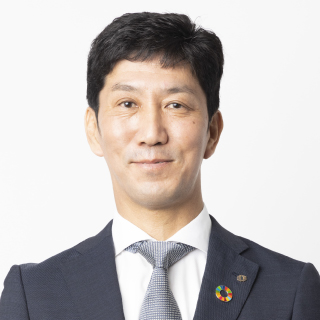Contributing to Resolve Social Issues
Herbicide AXEEV®
AXEEV®, an innovative field crop herbicide developed in-house that has a low impact on the environment, is Kumiai’s main product and the driver of our group’s growth. The product is registered as an agricultural chemical in 25 countries (As of April 2025) and is recognized as a trump card with long-term efficacy at low dosages against difficult-to-control herbicide-resistant weeds that have recently become a serious problem in the cultivation of soybean, corn, wheat, sugarcane, and other crops.
AXEEV® is used as an active ingredient in many products, supporting agriculture in the field and Contributing to food gloval production.

Food Insecurity, Worsening Global Environmental Issues, and the Spread of Herbicide-resistant Weeds
Increasing food production is an urgent issue in the world in order to support the world’s population, which is expected to reach 9.7 billion by 2050. At the same time, this means that severe damage to the environment will be inevitable including deforestation in order to expand more cropland. To increase food production without relying on the expansion of cropland, it’s necessary to improve productivity through the proper use of safe and secure agricultural chemicals that have passed the risk assessments on living organisms and the environment.
Recently, the impact of agricultural chemicals on the natural environment has drawn attention. In the EU, the “Farm to Fork Strategy” (Published by the European Commission in May 2020) and the “Strategy for Sustainable Food Systems, MIDORI” (announced by Ministry of Agriculture, Forestry and Fisheries in May 2021) in Japan were formulated to request less impact on the environment.
In the 1990s, genetically modified crops (GMOs*1) were introduced in the agriculture market that were tolerant to the non-selective herbicide glyphosate, and this had a major impact on the cultivation system. Cultivation systems using glyphosate capable of killing most plants and GMO crops tolerant to glyphosate were quickly accepted by growers due to its convenience. Currently, the system accounts for more than 90% of the soybeans and corn production in the Americas. However, a continuation of such a cultivation system resulted in a problem. Weeds that were resistant to glyphosate (herbicide-resistant weeds*2) began to appear. Glyphosate-resistant weeds were first reported around 2000, and it was becoming a problem around 2005. These had already begun a major problem worldwide when Axeev® was first launched in 2011. Currently, countermeasures are needed to control herbicide-resistant weeds in order to ensure stable food production throughout the world.
AXEEV®, which we developed, is widely accepted in the market as a tool to resolve such a problem, and although it has been over 10 years since the first launch, the number of countries where it is registered continues to increase along with sales.
- 1 GMO (Genetically Modified Organism): Crops that have been modified using genetic recombination technology. They are highly tolerant to diseases and pests and are not killed by herbicides.
- 2 Herbicide-resistant weeds: Weeds for which herbicides have lost effectiveness due to repeated use of the same type of herbicide.
Total number of reports on herbicide-resistant weeds
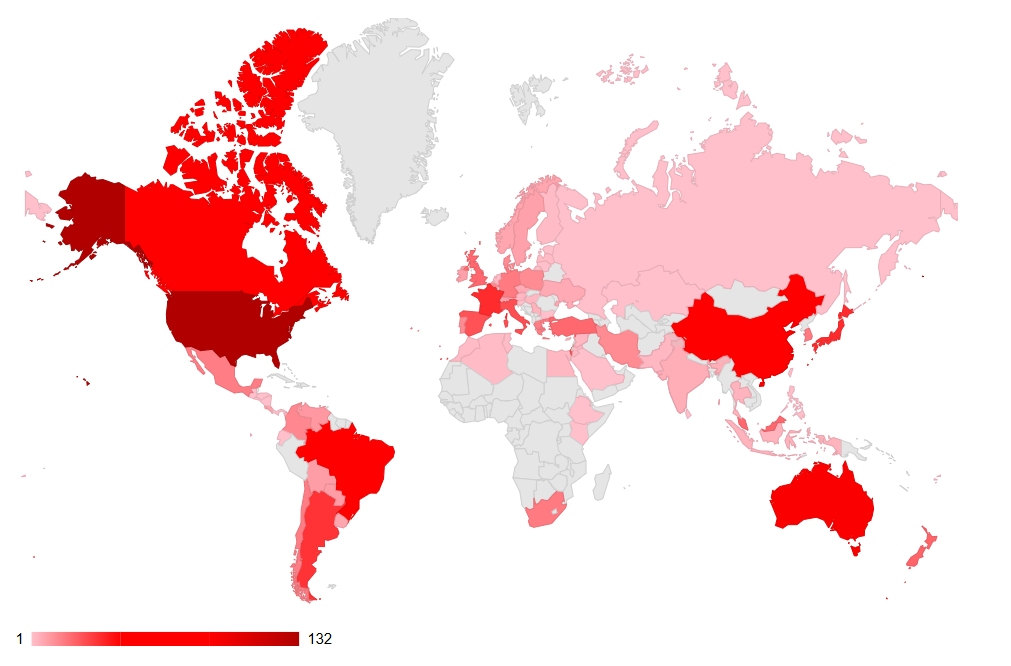
Herbicide-resistant weeds have spread to the countries and regions shown in light red to dark red on the map. The number of reported serious cases in the U.S. has reached 132.
Source: INTERNATIONAL HERBICIDE- RESISTANT WEED DATABASE (As of May 2025)
13 Years of Research and Development
Exploratory research for AXEEV® began with the aim of discovering a novel herbicide that provides the same efficacy at 1/10 the dosage of other conventional soil-applied herbicides *3 for field crops.
The lead compound of AXEEV® (the candidate compound we initially focused on) was synthesized in 1998, which showed potential for further development. At the same period, genetically modified crops (GMOs) with tolerance to the non-selective herbicide glyphosate began to appear, causing major changes to the cultivation system. The use of glyphosate together with GMO crops became a common cultivation system, which caused some companies to minimize or suspend research and development for new herbicides. However, based on the knowledge we had gained through our research and development up to that point, we continued our research and development of herbicides in anticipation of a time when new herbicides would be needed.
To discover new herbicides with high herbicidal efficacy and crop safety, we repeated synthesis and screening tests based on our lead compound, and in 2002, we finally discovered AXEEV® (active ingredient name: pyroxasulfone). Later, more than 100 trials were conducted on fields yearly in the U.S. Meanwhile, in Japan, research was conducted to establish global formulations and industrial manufacturing processes. AXEEV® is a soil-applied herbicide that is applied on the soil and the active ingredient is absorbed by weeds through the soil. Therefore, we needed to study various factors including the type of soil and the impact of rainfall amounts which may influence herbicidal efficacy and crop safety. We conducted a large number of studies in Japan and field trials in target countries and then finally determined the proper application dosages and application conditions in each market. We also conducted assessment studies on safety and environmental impact, which are required for the registration application of agricultural chemicals. It took considerable time and effort to prepare data for the registration application. In 2011, 13 years after the lead compound was first synthesized, we finally got the first registration approval of AXEEV® in Australia, and we launched the first AXEEV® product under the trade name SAKURA®.
- 3 Soil-applied herbicides: Herbicides that are applied onto the soil. Herbicides can be categorized into two types, soil-applied herbicides or foliar-applied herbicides.
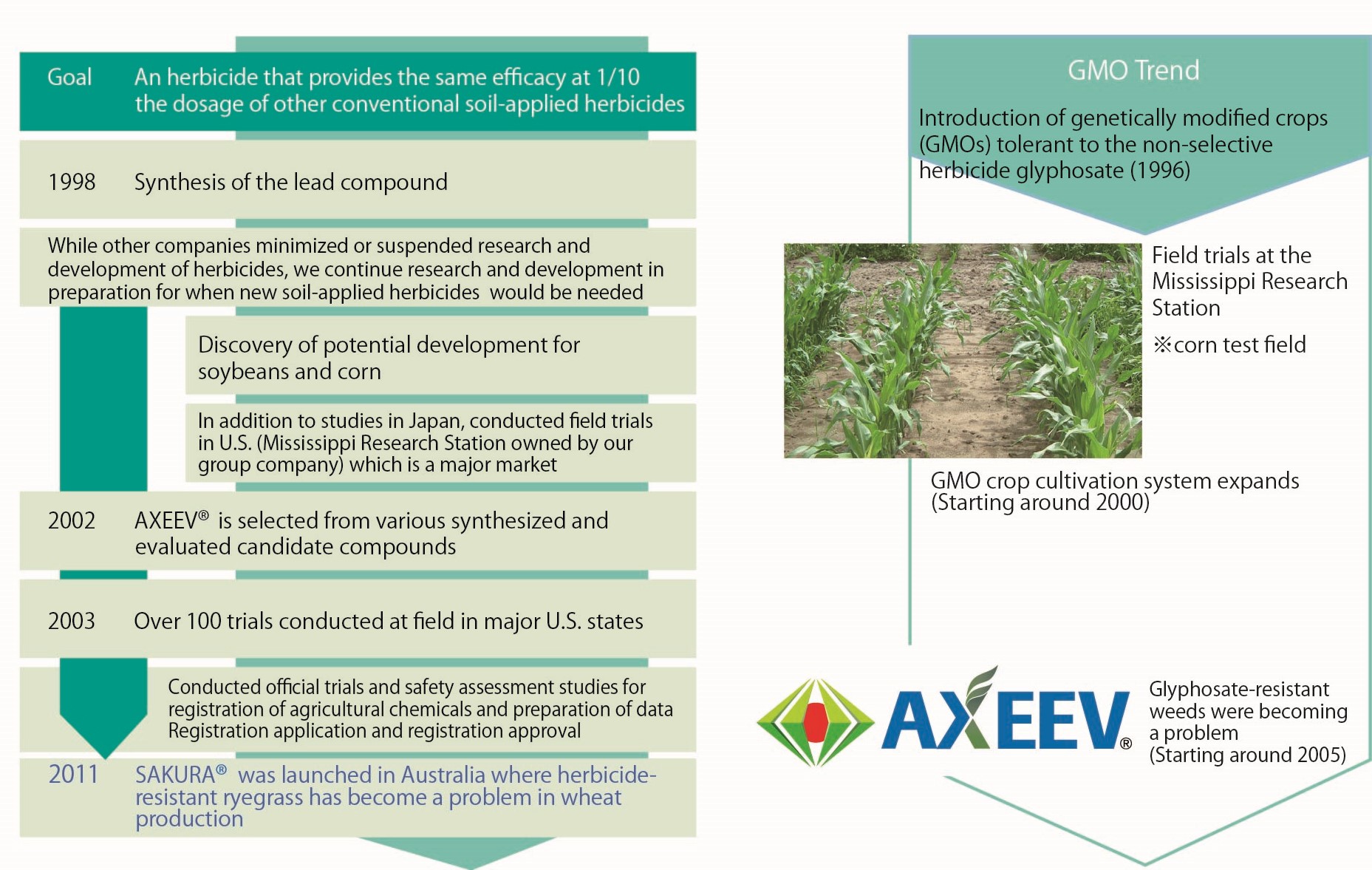
Unified Research and Development System
The Research and Development Division has a series of research institutes the Chemical Research Institute (New Molecule Research Center, Formulation Technology Research Center, Process Chemistry Research Center), and the Life Science Research Institute (Agrochemical Research Center, Life & Environment Research Center). Each research center, which plays a different role, collaborates to establish an integrated agricultural chemical research and development system, from the synthesis of new compounds to the study of industrial manufacturing processes.
Our group also owns a research station in Mississippi, the U.S., allowing us to have a system where site trials can be carried out at any time, which is essential for the global development of agricultural chemicals. Thanks to this system, AXEEV® could be discovered within a short period of about four years after exploration started, and the transition to industrialization was smooth.
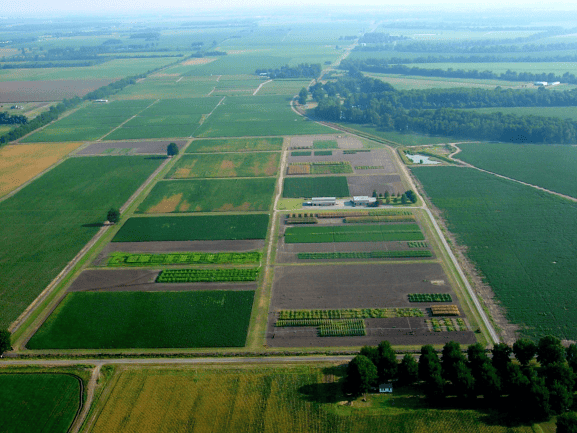
The efficacy of AXEEV® on soybean field
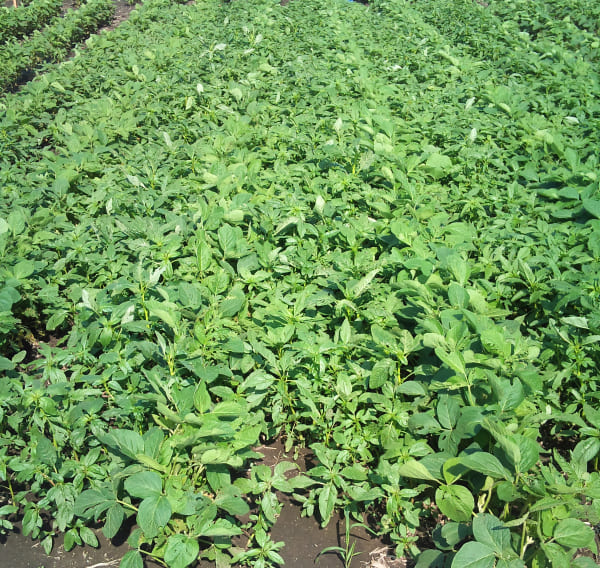
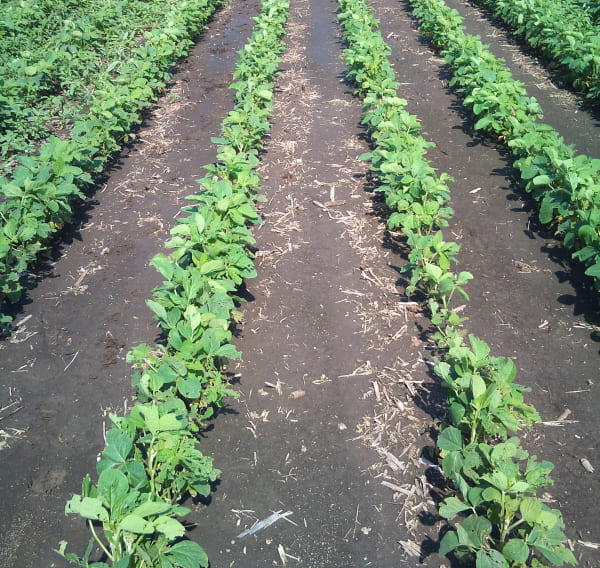
AXEEV® - Better productivity and lower environmental impact
AXEEV® is the brand name of the active ingredient “pyroxasulfone,” which is an agricultural chemical discovered and developed by Kumiai. Since its first launch in 2011, it has been the main product of our group and continues to grow steadily as a specific herbicide for controlling weeds that are resistant to conventional herbicides, and has helped to increase our business performance.
Improved productivity
Target crops
Applicable to major crops including soybeans, corn, wheat and sugarcane

Use applications
Soil-applied herbicide for field crops
Sprayed onto the soil before weeds germinate
Spraying AXEEV® forms a layer of AXEEV® on the soil surface. When AXEEV® is absorbed by soybean and weed sprouts, only the weeds are killed while the soybeans continue growing.
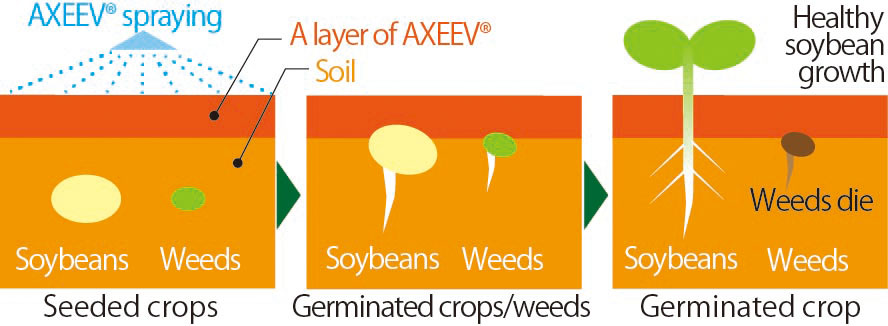
Strength 1
Highly effective against glyphosate-resistant weeds
Currently, more than 90% of soybeans and corn in the Americas is grown using a combination of the herbicide glyphosate, which kills most plants, with GMO crops tolerant to glyphosate. This cultivation system was introduced in the 1990s, but during the 2010s, resistant weeds to glyphosate became a major problem. Since AXEEV® provides excellent efficacy for controlling glyphosate-resistant weeds, it is in high demand in areas where such herbicide-resistant weeds have become a problem.
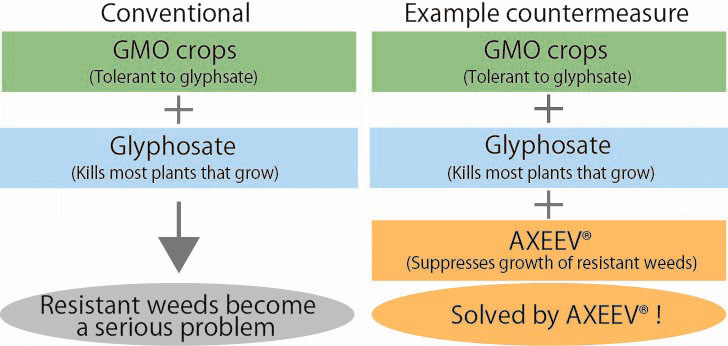
Strength 2
Low dosage
AXEEV® shows effectiveness at low dosage that are about 1/10 that of conventional soil-applied herbicides. This not only helps to reduce the labor needed for spraying agricultural chemicals, but it also Contributes to reduce the environmental impact and CO2 emissions related to transportation.
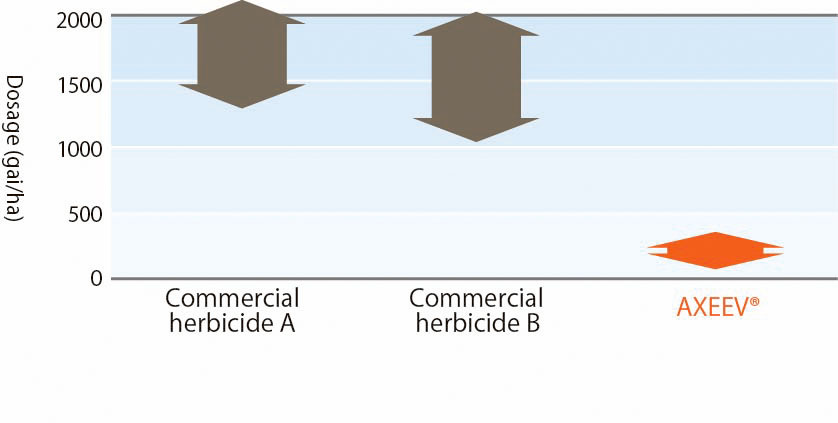
Strength 3
Excellent long-lasting weed control by soil-applied herbicide
AXEEV® is effective for about two weeks longer than conventional soil-applied herbicides. The negative impact of weeds on crops can be reduced, while better productivity and higher crop yield are expected as the results. Since it is possible to reduce the amount of agricultural chemicals being applied, it will reduce the environmental impact.
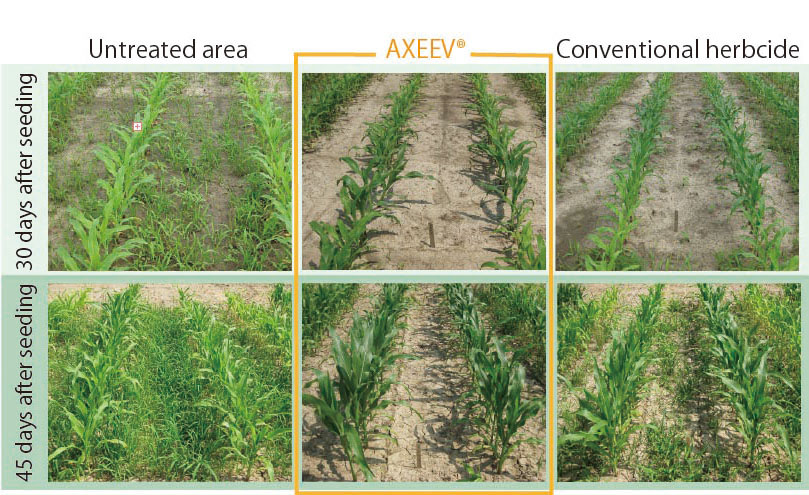
- The efficacy of AXEEV® in corn field
Strength 4
The mode of action making it difficult to develop resistance
AXEEV® has a mode of action that makes it difficult for resistance to be developed. Therefore, it is expected to continue to contribute to improved crop productivity as an herbicide-resistant weed control product.
Sales Trends & Strategies
Since its launch in Australia in 2011 as a soil-applied herbicide for wheat, AXEEV® has driven the growth of our group as a mainstay product.
Because it can be applicable to major crops such as soybeans, corn, wheat, and sugarcane, it is mainly sold in major markets including the U.S., Australia, Argentina, Brazil and India.
AXEEV® shows excellent long-lasting efficacy for controlling herbicide-resistant weeds, especially against ryegrass in wheat and amaranthus in soybean. We have taken advantage of this characteristic to provide technical service, conduct sales promotion of AXEEV® products, and introduce new mixture products in the markets where herbicide-resistant weeds are becoming a big problem. As a result, AXEEV® has come to be recognized among growers as an essential product for controlling herbicide-resistant weeds and established a position in the market.
We also have conducted sales promotion in countries where it is on the market, and are making an effort to expand the market by expanding its application to other crops while increasing the number of countries where it is registered. Now, AXEEV® products are registered in 25 countries(As of April 2025) and distributed through our partners in each country.
AXEEV® products are also developed for non-agricultural use, and distributed as a herbicide for turfgrass in golf courses in Japan and South Korea, and we are working to expand sales.
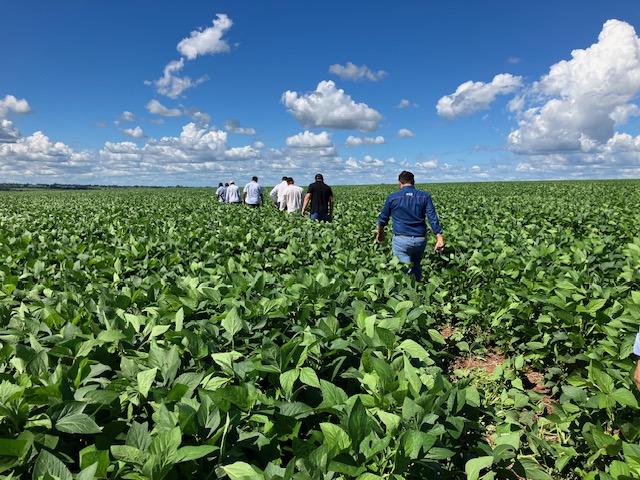
Future Prospects
The global agricultural chemicals market continues to grow, centering on South America and Asia, on the back of a growing world population and increasing demand for grain due to changes in dietary habits. According to AgbioInvestor, the market is projected to be worth 81.3 billion dollars in 2028.
Meanwhile, the agricultural chemicals market has been fluctuating greatly over the past few years. In 2022, the tense international situation led to a sharp rise in agricultural chemical prices and panic buying of agricultural inputs in the market. In 2023, agricultural chemical products were in plentiful supply, their prices fell, and optimization of distribution inventories, which had ballooned, began. The trend of inventory optimization and reduction continued in 2024 and affected sales of our products. A downward trend in grain prices and a fall in agricultural chemical prices are expected to continue and affect sales of our products in 2025.
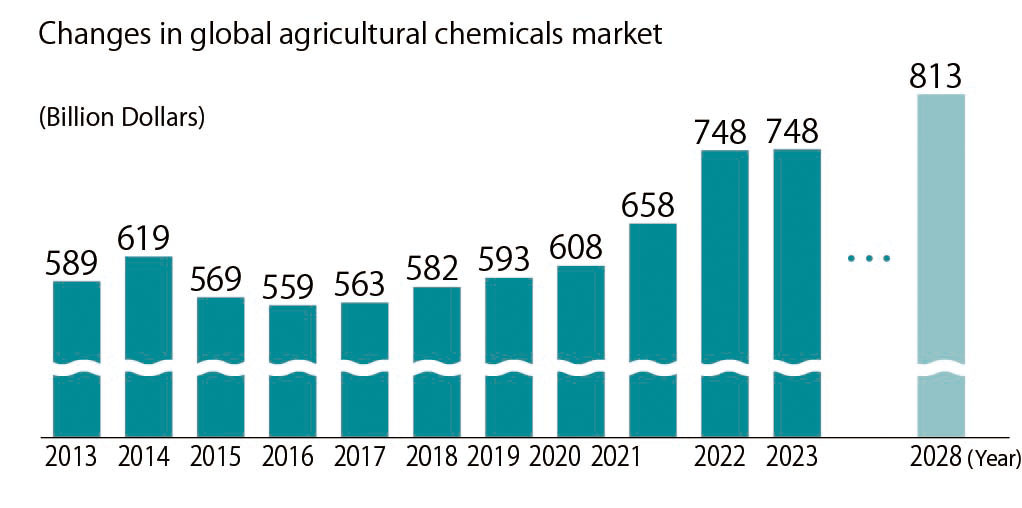
Since its launch in 2011, AXEEV® has driven our group’s growth as a special product for controlling weeds that are resistant to existing herbicides. On the other hand, due to the expiration of the substance patent in 2022, sales of AXEEV® are transitioning from the growth stage to the mature stage. In response, in order to maintain and expand sales of AXEEV®, we will strengthen measures such as sales promotion support, implementation of an appropriate pricing strategy, and promotion of the development of pre-mixtures. We will also strengthen competitiveness by further reducing production costs through the optimization of the supply chain in Japan and overseas. Further, we will implement an intellectual property strategy utilizing multiple patents owned by us, such as those for pre-mixtures and manufacturing methods. We will take decisive action in the event of any infringement of our intellectual property. Since FY2024, we have taken legal action against several companies and, among 11 patent enforcement proceedings, as of April 2025, we have secured two settlements in our favor, with the remaining cases still pending. We believe that these responses are effective in discouraging illegal market entries and that they will have a strong impact on the AXEEV® business in the future.
Comments from the synthesis and development researcher of AXEEV®
Synthesis Researcher of AXEEV® NAKATANI Masao(Currently: Deputy General Manager of Research & Development Planning Department of Research & Development Division)
While the planting area of GMO crops had expanded, we focused on soil-applied herbicides which had a stable position in the market, and started exploratory research. We were disappointed in the early stages of research because all plants, including crops, were killed by candidate compounds. However, based on a large amount of data and past know-how accumulated from years of research including such a study, we could establish a hypothesis, conduct verification, and perform continuous examination, ultimately resulting in the discovery of AXEEV®. We were able to conduct on a tight schedule the synthesis of candidate compounds, screening trials, and early-stage safety assessment studies in parallel, targeting to carry out field trials in the season in the U.S. I believe it led to the success of optimization research in a short period.
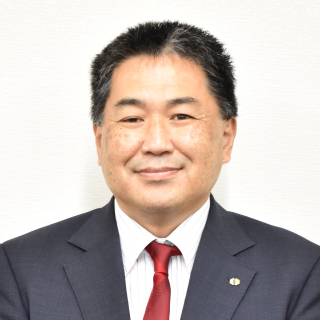
Development Researcher of AXEEV® YAMAJI Yoshihiro(Currently: Director, Managing Executive Officer, Head of Corporate Planning & Coordination Division)
At the time, it was said that no herbicides other than glyphosate would be needed after the introduction of genetically modified crops. However, we recognized that glyphosate has a short effective period, so we aspired to develop a soil-applied herbicide with a long residual activity for which it is more difficult to develop resistance. The development of AXEEV® required the technology, know-how, and efforts of many people and was a great achievement by Kumiai as a company. This accomplishment has been passed on to the next generation and it continues evolving into new opportunities.
